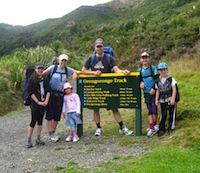As a break from tradition, and in line with this month’s topic Growing Great Families, I’ve decided to talk about one activity that the whole family enjoys.
I’m a lover of tramping. I’ve always wanted to get into it but never really had the opportunity until about 2004.
I started my tramping in Auckland, where I would meet like-minded people on social tramps twice a month. They generally involved tracks around the Waitakere Ranges, and sometimes the Hunua Ranges.
While these experiences were enjoyable, I often found them similar in not only location but vegetation as well. I was keen for more and decided that the place I wanted to experience that in was the South Island.
In 2006, I moved to Christchurch. Shortly after, I joined one of the many local tramping clubs.
Living in Canterbury (earthquakes aside) is fantastic. There is so much opportunity for tramping. So many different locations and plenty of choice regardless of what your experience is.
I often come across families tramping, and one thing that strikes me is how happy they all are! Kids love being outside and even more so when they are tramping with mum and dad.
To me, it really does bring a family closer together. Everyone is on the same playing field. Everyone pitches in. Kids feel empowered because they are carrying their own pack with their own gear in. They are self contained.
How Do I find Suitable Locations?
Finding suitable locations is easy. The best place to search is on the Department of Conservation website. On the site you will be able to search by region, then search ‘places to stay’.
There are over 900 huts in New Zealand administered by DOC, and there are three classifications of huts besides those on the Great Walks.
All DOC huts have no electricity, so trampers must supply their own lighting. A torch and candles are a must. Likewise, cooking facilities are not provided, so trampers need their own cookers. The range of small portable cookers is wide and some pack down very small.
It’s always interesting to see what other people are cooking. Most people bring food such as dried pasta, rehydrating it in boiling water, and adding either meat, vegetables or both.
Some of the newer DOC huts are now double glazed, and often have fly screen nets on the windows. Double glazing is great in the winter, while the fly screen nets help keep the mozzies out in the summer.
All huts have outdoor toilet facilities.
Don’t worry about the cold weather. The majority of the DOC huts have enclosed cast iron fireplaces. In most places, fuel is supplied. Wood is often the choice, and additional wood can be chopped from surrounding dead trees. In some huts, especially those on or near the West Coast of the South Island, coal is supplied as fuel. Coal is great. Although it takes a while to get going, it really burns hot and you will be toasty warm inside, no matter what the weather is like outside.
How Much Does it Cost?
Most DOC huts work on an honesty ticket system. Standard huts cost about $15 per night while some more basic huts are around $5 per night. Tickets are available for purchase from any DOC office.
For families that are starting out, choose an easy tramping location that will take not more than 3 hours. There are plenty available. That’s long enough to know you all used up energy getting there, but still have enough for some fun on arrival.
Building great families is what it is about. Why not organise some gear, and take your family on their first tramp soon!






